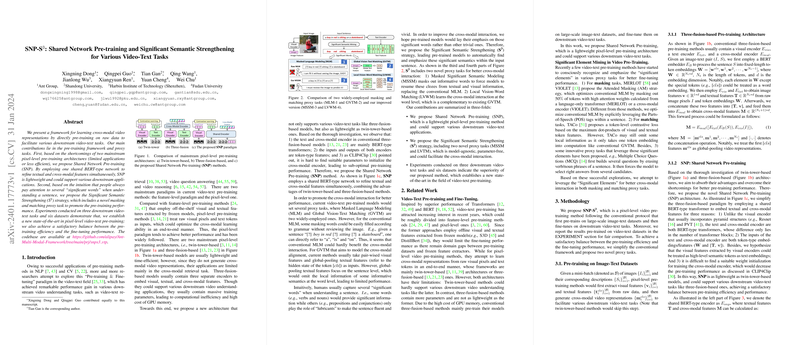Review of "SNP-S: Shared Network Pre-training and Significant Semantic Strengthening for Various Video-Text Tasks"
The paper introduces SNP-S, a framework aimed at enhancing video-text tasks through improved pre-training architectures and novel proxy tasks. It contributes significantly to the ongoing development of pixel-level pre-training methods within the field of cross-modal learning.
Framework and Innovations
The authors identify limitations in existing pixel-level pre-training architectures, which are predominantly twin-tower-based and three-fusion-based. Although twin-tower models are lightweight, they primarily target cross-modal retrieval tasks. In contrast, three-fusion models, while supporting diverse applications, demand substantial computational resources due to their extensive parameter requirements. To strike a balance, the authors propose Shared Network Pre-training (SNP), which integrates a shared BERT-type network to process textual and cross-modal features, thus streamlining the architecture and enhancing efficiency without sacrificing application versatility.
Furthermore, the paper addresses the inadequacy of existing masking and matching proxy tasks, namely Masked LLMing (MLM) and Global Vision-Text Matching (GVTM), in promoting cross-modal interactions. The authors propose the Significant Semantic Strengthening (S) strategy, which emphasizes informative semantic elements by focusing on verbs, nouns, and adjectives. This includes Masked Significant Semantic Modeling (MSSM) and Local Vision-Word Matching (LVWM), aiming to improve cross-modal interaction by leveraging significant elements, based on the intuition that humans concentrate on key words to comprehend sentences.
Empirical Evaluation
The authors validate their approach on three downstream video-text tasks across six datasets. The SNP-S framework sets new benchmarks in these tasks, demonstrating superior performance over state-of-the-art methods such as Frozen and VIOLET on text-to-video retrieval tasks. Specifically, SNP-S shows significant improvements in recall metrics across multiple datasets, indicating its robust capabilities in accurately aligning video-text pairs.
Furthermore, the framework exhibits advantageous characteristics in computational efficiency, requiring fewer parameters and offering expedited convergence compared to traditional three-fusion models. This efficiency is particularly notable given the lightweight nature of the SNP architecture.
Implications and Future Work
The implications of this research are two-fold. Practically, SNP-S offers a more effective and efficient pre-training framework that can be immediately beneficial for various video-text tasks in real-world applications, highlighting its potential impact on multimedia retrieval systems and automated content understanding. Theoretically, the successful implementation of a shared network methodology encourages further investigation into parameter sharing mechanisms across different modalities, which may spur advancements in multi-task learning frameworks.
Future avenues for research could explore adaptive mechanisms for selecting significant semantics, moving towards a more context-sensitive approach that could potentially enhance model adaptability further. Moreover, extending the shared encoder concept to include visual feature embedding could provide comprehensive end-to-end solutions for video-text tasks.
In conclusion, SNP-S positions itself as a competitive contender through its architectural efficiency and robust interaction modeling, providing promising prospects for the next phase of advancements in video-text understanding.
